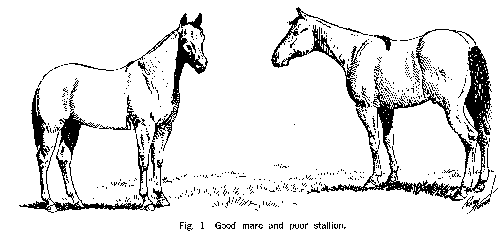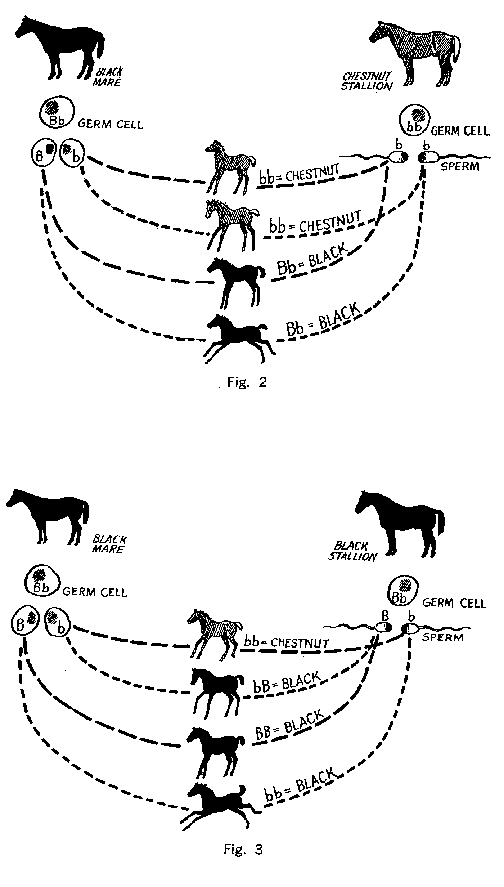BREEDING & CONFORMATION
By Murray E Fowles, DVM
Illustrated by Randy Steffen
Reprinted form the December 1960 Quarter Horse Journal
Now is the time of year to be concerned about conformation defects in relation to the breeding program. The breeder is now deciding which mare is going to which stallion come spring. He must evaluate the qualities of each animal he owns, as well as the characteristics of the stallions he sends mares.
The question may be: Will stallion X offset the poor head of my mare B? If so, the foal may have a better chance of having a good head. No animal is perfect. Conformation can always be improved. Proper breeding combinations are the only available means of bring out these desirable conformation and disposition qualities which you, as a breeder, have set to work towards. Conversely, improper combinations can lead to failure for the individual breeder. Moreover, if many people concentrate on one characteristic without regard to other factors the end result can degrade a whole breed. This has happened a number of times with various breeds of dogs.

Genetics, the science of heredity or breeding, being very complex, cannot be explained fully in a short article. Just the same, I am continually bombarded with such questions as: "Is ringbone hereditary?", "are spavins congenital?" "Did the stallion cause my foal to have crooked legs?" I can discuss a few of these points and help breeders to be aware that conformation defects can be controlled, within reason, by a sound approach to the problem.
A congenital condition is one present at birth -- crooked legs, buck knees, parrot mouth or one of dozens of other defects. This is in contrast to a condition acquired after birth, one that shows later in the life of the foal. For instance, a foal may have perfectly straight legs when born but develop calf-knees or cow hocks later. An acquired character is not inherited.
The term "hereditary", probably is misused more than any other. Webster says it refers to a characteristic that is "transmitted, or transmissible, as a constitutional quality or condition from parent to offspring." To understand this we must delve a little deeper into how a foal develops from the ovum (egg) of the mare and the sperm of the stallion.
The body is composed of many different types of microscopic units, called cells. Some have the function of aiding in digestion and the assimilation of food, and some are concerned in breathing, and some are concerned with reproducing another body like itís own. Each cell has what is called genetic make-up, or a pair of genes for each characteristic that makes up the body. The germ cells (sperm and ova), however, are the only ones the can pass characteristics on to future generations.
As mentioned, the foal develops from the union of the ovum and sperm. If this union resulted in a pair of genes for each characteristic from each parent, there would be two pair. This canít be, so nature has seen to it that there is a splitting of each pair of genes in the development of the germ cells. Thus a given sperm has only one gene for one characteristic. When the gene from the ovum unites with the gene from the sperm, nature is back on course.
Of course, the process is much more complex than it seems form this simplified explanation. No single pair of genes controls such a characteristic as crooked legs; probably many are involved in a complex interaction. Characteristics such as coat color, however are less complex. Scientist studying colors are able to predict in general which colors will result form given matings.
Since the coat color is more easily understood, letís use it as an example to show how a foalís genes are derived from the sire and dam.
The pair of genes for color in a black horse are either BB (B = black) or Bb (b = chestnut). A chestnut horse will have genes bb. Notice that, even though the black horse has a small "b" in the one case, it is still black. That is because "B" is dominant over "b", or expressed the other way "b." is recessive to "B". Many genetic characteristics are of this type. others, such as color in shorthorn cattle, show a mixture of the two. RR = red, Rr - roan, and rr = white.
Let us now consider the genetic possibilities of mating various combinations of black and chestnut horses. Suppose the mare has a genotype (genetic makeup for a given characteristic) of Bb. She will be black, but she will carry a chestnut gene. The stallionís genotype is bb, so he is a chestnut. Refer to the illustration to see the results (Figure 2).

This means that in the mating there is a 50-50 chance that the foal will be either black or chestnut. Keep in mind now what would be happening if bb meant cow-hocks and Bb meant good hocks.
One of the most difficult questions to answer for the horse breeder is, " If cow-hocks are hereditary, why do only a few of the foals from my cow-hocked stallion have cow-hocks?" That is explained on the basis of genetic percentages. Applying this simplified explanation to something like cow-hocks, one can see how a stallion with cow-hocks could produce some foals with cow-hocks and some with sound legs.
It is even conceivable that a cow-hocked stallion would never have a cow-hocked foal from a mare with a genotype of BB, because any combination would result in Bb. Again, I have simplified things to show genetic principles.
Now, consider another possibility. Both animals are black (see Figure 3) but carry a gene for chestnut. There is a 3-1 possibility that the foal will be black. Suppose in this case that b is an undesirable conformation trait, such as calf knees. Both the mare and stallion would have good knees, but carry a gene for calf knees. On an average, 1 out of 4 foals show up with calf-knees.
This type of thing mat happen in line-breeding (the mating of closely related individuals). I am not opposed to line breeding, for it strengthens good characteristics too. But the breeder who uses it must be able and willing to cull the animals that show defects.
I have restricted myself to supposing and assuming. Why? Because we donít know whether parrot-mouth is controlled by one set of genes: and if it is dominant or recessive -- or even hereditary. We would like to know, and also know how spavins and ringbones are passed on. Some research is being done in these areas, but much more will have to be done before we can set forth on paper the probable outcome of mating stallion A to mare B. Even so, we know enough that we can apply general principals to the selection and mating of breeding stock.
When the sperm and ovum unite, the genetic makeup of the foal is set. Even so, there are many chances for nature to go astray during the development of this union of two microscopic cells into the millions that make up the foalís body. To me it is a marvel of supreme organization that deformed foals are not more common. Accidents like an underdeveloped leg are an example. Some people believe that club-foot comes about in this manner. I question this. In most of the cases I have seen, it is the result of the shortening of the tendons on the back side of the leg. That is a congenital conformation defect.
We have not discussed the importance of nutrition as it relates to conformation. Certainly a foal from an underfed mare has less chance to grow up sound, and skipping on the groceries while he is growing up may result in rickets. However, too many foals bred and raised under ideal nutrition conditions have serious conformational faults for me to believe that nutrition is the whole answer.
As I have mentioned, no animal is perfect but the wise breeder will steer clear of breeding animals with severe conformation defects. What are serious defects. Any defect that puts added stress on the hocks is undesirable, because the Quarter Horse in his daily work needs strong hocks. Such things as "sickle-hock" " cow-hock", or bowed hocks" all predispose the horse to the development of arthritis in the hock (spavin) or curbs. Calf-kneed horses are predisposed to arthritis of the knee (popped knee). Horse with straight pasterns are more prone to development of arthritis of the pastern joint (ringbone). Some conformation defects are certainly more serious than others, but nearly all put undue strain on other parts of the horse. I have little doubt that most of these defects are hereditary.
With the information now available, we canít say that a spavin is hereditary, but to the alert breeder this isnít necessary. If he knows that a horse with weak hocks has a better than average chance of developing spavin, he knows what to watch for. We should be aware that a horse can develop a ringbone or a spavin from causes unrelated to conformation - - a kick in the hock or a sever cut over the pastern. The important thing is to not be misled, not to think your horse couldnít possibly have a conformation defect but must have hurt himself. To summarize briefly, several factors may be acting to cause conformation defects: (1) nutrition, both before and after birth; (2) developmental defects occurring in the uterus (womb); (3) injuries occurring after birth; and (4) hereditary factors based on the genetic makeup of the mare and the stallion. The last, I believe is the most important consideration.
The breeder has some control over all the factors except (2), development in the uterus. Success as a breeder will depend on the attention paid to these factors. Remember, balance is important. Donít concentrate on breeding for a beautiful head without considering heart-girth and shoulder angle. Donít stress good withers and forget disposition. Donít concern concentrate on massive muscle in the gaskin to the neglect of good straight legs.
Remember like begets like.
-------------------------------------------------------------------------------------------------
Definitions of Terms
Used In This Article
Acquired -- A trait that develops after birth and is not hereditary.
Assimilation -- The absorption and utilization of food.
Bowed Hock -- A bowing out of the hind leg.
Buck-knee -- When the knee is sprung forward.
Calf-Kneed -- When the knee is sprung backward.
Congenital -- Present at birth.
Cow Hocks -- When the hocks are tuned in and the toes out.
Curb -- A swelling at the back of the hock about 5" blow the point of the hock.
Dominant -- A gene which overshadows others.
Gene -- The biological unit of heredity.
Genetics -- The stud of the gene.
Genotype -- The combination of genes of an individual.
Heredity -- The study of the characteristics passed through germ plasm.
Ovum -- The female reproductive cell.
Parrot Mouth -- When the upper jaw extends past the lower so that the front teeth donít meet.
Popped Knee -- Inflammation or swelling of the knee.
Predisposed -- A tendency toward a disease or condition.
Recessive -- A gene which requires a pair of to show that character.
Rickets -- A nutritional disease resulting in poor bone structure.
Ringbone -- Arthritis (inflammation) of pastern.
Sickle Hocks -- When the cannon none slopes forward and down instead of straight down.
Spavin -- Arthritis of hock.
Sperm -- The male reproductive cell.